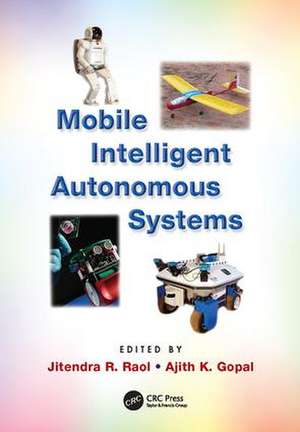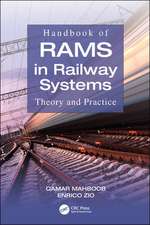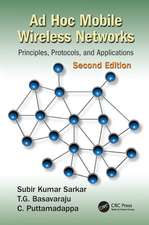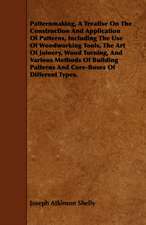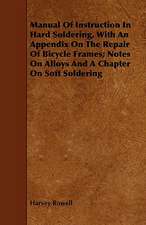Mobile Intelligent Autonomous Systems
Editat de Jitendra R. Raol, Ajith K. Gopalen Limba Engleză Paperback – 29 mar 2017
- Path and motion planning
- Obstacle avoidance in a dynamic environment
- Direct biological-brain control of a mobile robot
- Sensor and image data fusion
- Autonomous decision making and behavior modeling in robots
- Hydro-MiNa robot technology
- Adaptive algorithms for smart antennas
- Control methods for autonomous micro-air vehicles
- Neuro-fuzzy fault-tolerant auto-landing for aircraft
- H-infinity filter based estimation for simultaneous localization and mapping
| Toate formatele și edițiile | Preț | Express |
|---|---|---|
| Paperback (1) | 585.27 lei 43-57 zile | |
| CRC Press – 29 mar 2017 | 585.27 lei 43-57 zile | |
| Hardback (1) | 1423.31 lei 43-57 zile | |
| CRC Press – 15 aug 2012 | 1423.31 lei 43-57 zile |
Preț: 585.27 lei
Preț vechi: 688.56 lei
-15% Nou
Puncte Express: 878
Preț estimativ în valută:
111.99€ • 117.22$ • 93.21£
111.99€ • 117.22$ • 93.21£
Carte tipărită la comandă
Livrare economică 31 martie-14 aprilie
Preluare comenzi: 021 569.72.76
Specificații
ISBN-13: 9781138072459
ISBN-10: 1138072451
Pagini: 832
Ilustrații: 839 equations, 7 in text boxes; 78 Tables, black and white; 478 Illustrations, black and white
Dimensiuni: 178 x 254 x 42 mm
Greutate: 0.45 kg
Ediția:1
Editura: CRC Press
Colecția CRC Press
Locul publicării:Boca Raton, United States
ISBN-10: 1138072451
Pagini: 832
Ilustrații: 839 equations, 7 in text boxes; 78 Tables, black and white; 478 Illustrations, black and white
Dimensiuni: 178 x 254 x 42 mm
Greutate: 0.45 kg
Ediția:1
Editura: CRC Press
Colecția CRC Press
Locul publicării:Boca Raton, United States
Public țintă
Professional Practice & DevelopmentCuprins
Introduction. Part I Conceptual Foundations for MIAS: Neuro-Fuzzy–GA–AI Paradigms. Mathematical Models of Robot Motion. Data Fusion in Mobile Intelligent Autonomous Systems. Image Registration and Fusion. Multi-Sensor Image Fusion Using Discrete Cosine Transform. Motion Segmentation Using Spectral Framework. Formation Control in Multi-Agent Systems over Packet Dropping Links. Part II MIAS and Robotics: Robot’s Sensors and Instrumentation. Robot Navigation and Guidance. Robot Path and Motion Planning. Out-of-Sequence Measurements: Missing Data Problem. Robotic Path-Planning in Dynamic and Uncertain Environment Using Genetic Algorithm. Temporal Logic Motion Planning in Robotics. A Constraint Programming Solution for the Military Unit Path Finding Problem. Simultaneous Localization and Mapping for a Mobile Vehicle. Robotic and Moving Vehicle Architectures. Multi-Robot Coordination. Autonomous Mobile Robot with a Biological Brain. Safe and Effective Autonomous Decision Making in Mobile Robots. Partially Integrated Guidance and Control of Unmanned Aerial Vehicles for Reactive Obstacle Avoidance. Impedance-Controlled Mechatronic Systems for Autonomous Intelligent Devices. Hydro-MiNa Robot Technology for Micro- and Nano-Manipulation in Manufacturing of Micro-Products. Part III Allied Technologies for MIAS/Robotics: Real-Time System Identification of an Unstable Vehicle within a Closed Loop. Smart Antennas for Mobile Autonomous Systems: Adaptive Algorithms for Acceleration. Integrated Modelling, Simulation and Controller Design for an Autonomous Quadrotor Micro Air Vehicle. Determination of Impact and Launch Points of a Mobile Vehicle Using Kalman Filter and Smoother. Novel Stability Augmentation System for Micro Air Vehicle: Towards Autonomous Flight. Neuro-Fuzzy Fault-Tolerant Aircraft Autoland Controllers. Reconfiguration in Flight Critical Aerospace Applications. Study of Three Different Philosophies to Automatic Target Recognition: Classical, Bayesian and Neural Networks. Real-Time Implementation of a Novel Fault Detection and Accommodation Algorithm for an Air-Breathing Combustion System. Fuzzy Logic-Based Sensor and Control Surface Fault Detection and Reconfiguration. Target Tracking Using a 2D Radar. Investigating the Use of Bayesian Network and k-NN Models to Develop Behaviours for Autonomous Robots. Modelling Out-of-Sequence Measurements: A Copulas-Based Approach. Appendix A: Statistical and Numerical Concepts. Appendix B: Notes on Software and Algorithms Related to Robotics. Index
Notă biografică
Jitendra R. Raol, Ph.D., is retired from the National Aerospace Laboratories (NAL), where he was Scientist-G and head of the Flight Mechanics and Control Division (FMCD). He was elected a fellow of the IEE (UK), was a senior member of the IEEE (US), is a life-fellow of the Aeronautical Society of India, and a life member of the System Society of India. Dr. Raol has published 110 research papers and several reports and has guest-edited two special issues each of Sadhana and the Defense Science Journal. He is a reviewer of several national and international journals and has served as a chairman and member of several technical and examination committees. He is the (co-) author of Modelling and Parameter Estimation for Dynamic Systems, (IEE/IET, 2004), Flight Mechanics Modeling and Analysis (CRC Press, 2008) and Multi-Sensor Data Fusion with MATLAB (CRC Press, 2009). He has also written collections of poems: Poetry of Life, Sandy Bonds, Timeless Quest, and Naked Emotions.
Ajith K. Gopal, Ph.D., is currently an engineering manager at Land Systems South Africa, where he is responsible for new technology strategy and development for the company. In 2007, Dr. Gopal established the MIAS (Mobile, Intelligent, Autonomous Systems) research group at the Council of Scientific and Industrial Research (CSIR) in South Africa, where he served as the research leader for 2007 and 2008. He has published four papers relating to composite and smart materials in the Journal of Composite Materials and International Conferences on Composite Science and Technology. He has also published a paper on path planning in the Defense Science Journal and a book chapter on data fusion in robotics in Multi-Sensor Data Fusion with MATLAB (CRC Press, 2009) and has guest-edited a special issue of the Defense Science Journal on MIAS.
Ajith K. Gopal, Ph.D., is currently an engineering manager at Land Systems South Africa, where he is responsible for new technology strategy and development for the company. In 2007, Dr. Gopal established the MIAS (Mobile, Intelligent, Autonomous Systems) research group at the Council of Scientific and Industrial Research (CSIR) in South Africa, where he served as the research leader for 2007 and 2008. He has published four papers relating to composite and smart materials in the Journal of Composite Materials and International Conferences on Composite Science and Technology. He has also published a paper on path planning in the Defense Science Journal and a book chapter on data fusion in robotics in Multi-Sensor Data Fusion with MATLAB (CRC Press, 2009) and has guest-edited a special issue of the Defense Science Journal on MIAS.
Recenzii
"This edited collection brings forth a variety of state-of-the-art research results in areas relevant to mobile intelligent systems such as UAVs and robots. The topics are complementary while the treatment of these topics within each chapter is very detailed. This book will greatly benefit robotics researchers and developers as a go-to source for understanding the myriad topics related to incorporation of autonomy in mobile intelligent systems."
—Aman Behal, University of Central Florida, USA
"[This book] can be recommended to research (PhD and post-PhD) students or for industrial implementations."
—Florin Ionescu, Steinbeis University Berlin and STI Dynamic Systems, Germany
"… a great book to get an overall and in-depth understanding for this field."
—Zhao Wang, University of Central Florida, Orlando, USA
—Aman Behal, University of Central Florida, USA
"[This book] can be recommended to research (PhD and post-PhD) students or for industrial implementations."
—Florin Ionescu, Steinbeis University Berlin and STI Dynamic Systems, Germany
"… a great book to get an overall and in-depth understanding for this field."
—Zhao Wang, University of Central Florida, Orlando, USA
Descriere
Going beyond the traditional field of robotics to include other mobile vehicles, this reference and "recipe book" describes important theoretical concepts, techniques, and applications that can be used to build truly mobile intelligent autonomous systems (MIAS). With the infusion of neural networks, fuzzy logic, and genetic algorithm paradigms for MIAS, it blends modeling, sensors, control, estimation, optimization, signal processing, and heuristic methods in MIAS and robotics, and includes examples and applications throughout. Offering a comprehensive view of important topics, it helps readers understand the subject from a system-theoretic and practical point of view.
